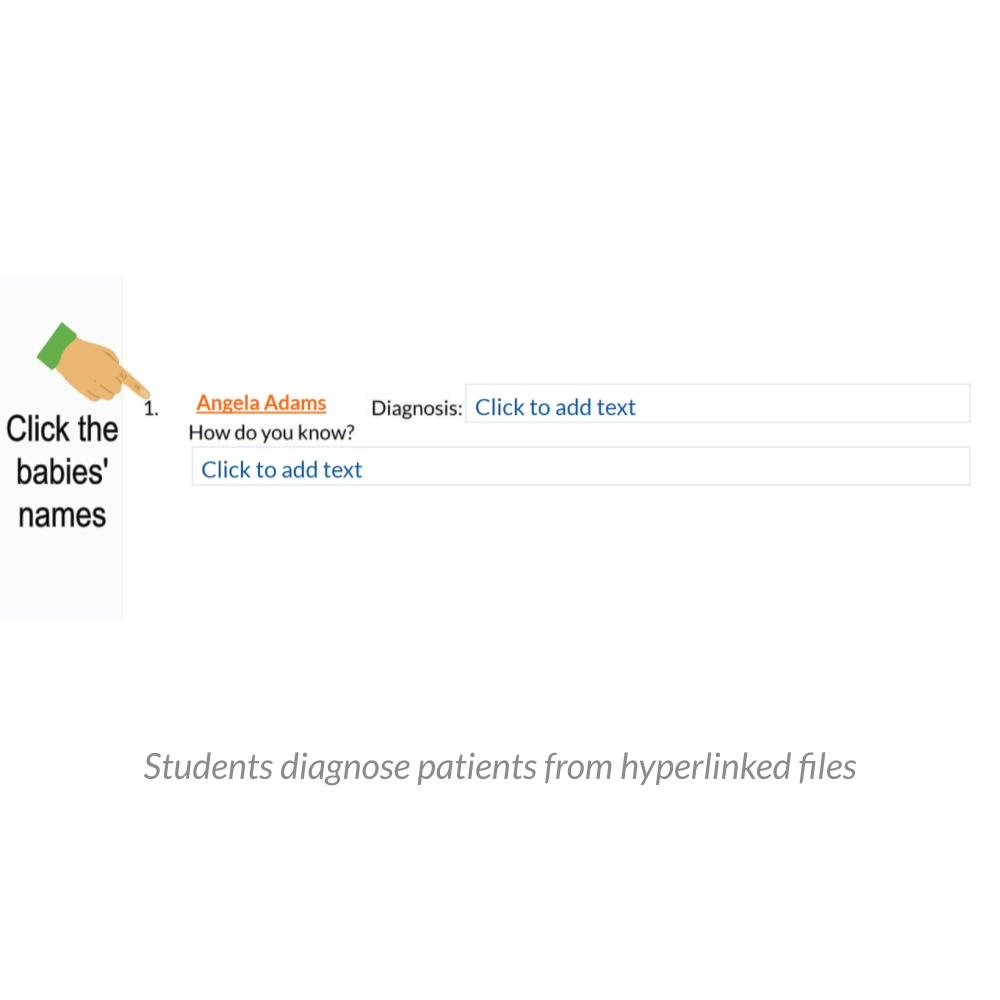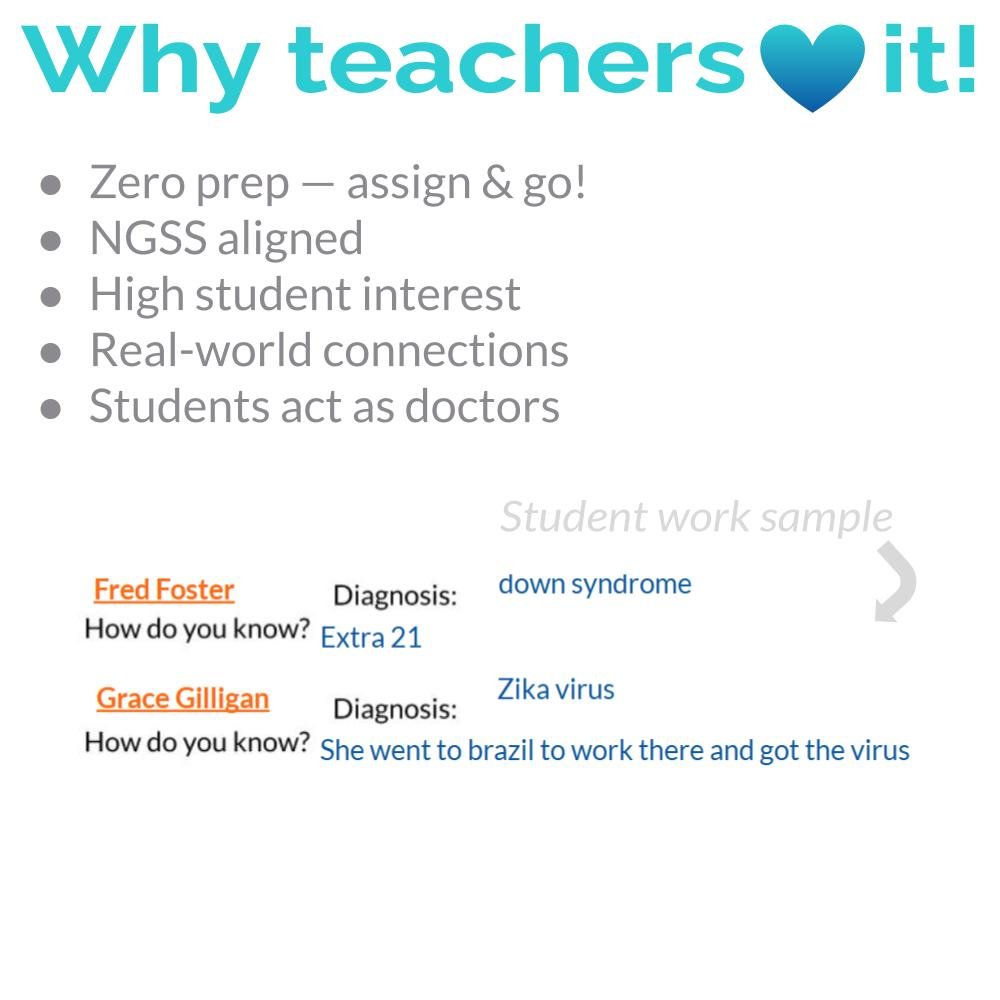



Diagnosing Birth Defects Digital Lab | Teratogens, Karyotypes & Chromosomal Disorders
Students analyze medical histories and karyotypes to diagnose genetic and environmental birth defects.
Engage your students in a captivating digital learning experience that transforms them into real-life doctors. This meticulously designed Google Slides lesson empowers students to take on the role of medical detectives, delving into the complex world of birth defect diagnosis.
Why Choose Our Birth Defect Diagnosis Lesson?
Real-World Medical Simulation: Immerse students in the shoes of healthcare professionals as they analyze medical documents to diagnose birth defects. This hands-on approach not only sharpens their analytical skills but also instills a sense of responsibility and empathy.
Comprehensive Learning Path: The lesson begins by reinforcing the concept of placental diffusion, ensuring students have a solid foundation. They then delve into the distinction between mutagens and teratogens, equipping them with essential knowledge for the diagnostic task ahead.
Expert Guidance: Two informative slides introduce students to common teratogens and provide invaluable hints for their medical detective work. Additionally, students receive a "karyotype key" to swiftly identify chromosomal syndromes, enhancing their diagnostic precision.
Diagnostic Challenge: Armed with medical forms and karyotypes for 10 infants born with birth defects, students embark on a compelling diagnostic journey. Each case requires them to meticulously diagnose the presented syndrome or condition, supported by evidence extracted from the documents.
Empower Your Students:
Encourage critical thinking, analytical prowess, and a deeper understanding of birth defects. This lesson fosters a sense of purpose and professionalism, offering students an authentic glimpse into the medical field.
Ignite Curiosity, Foster Empathy:
Transform remote learning into an engaging medical detective mission. Download our Google Slides lesson now and watch as your students eagerly take on the challenge of diagnosing birth defects.
*Students should be familiar with karyotypes and know how to read them before this lesson.
To preview this lesson, click here
Grade & Course Recommendation:
High School:Grades 9–11 biology or human anatomy/health science unit on reproduction and development.
Cross-Curricular Connections:
Health Science Integration: Links to prenatal care, genetic counseling, and environmental health.
ELA Integration: Students interpret case studies and construct written diagnostic reasoning.
Ethics & Social Studies Integration: Discussion of medical ethics and prevention strategies.
Daily slide + literacy - based exit ticket included with purchase
Join the Lesson Laboratory and Teach for Tomorrow!
NGSS (Next Generation Science Standards)
HS-LS3-1: Ask questions to clarify relationships about the role of DNA and chromosomes in coding the instructions for characteristic traits passed from parents to offspring.
HS-LS3-2: Make and defend a claim based on evidence that inheritable genetic variations may result from new genetic combinations through meiosis, errors during replication, and/or mutations caused by environmental factors.
HS-LS3-3: Apply concepts of statistics and probability to explain the variation and distribution of expressed traits in a population.
HS-LS1-1: Construct an explanation based on evidence for how the structure of DNA determines the structure of proteins, which carry out the essential functions of life.
HS-ETS1-3: Evaluate a solution to a complex real-world problem based on prioritized criteria and trade-offs. (connection: analyzing the ethics and societal implications of prenatal diagnosis and medical interventions)
Science & Engineering Practices: Analyzing and interpreting data; Constructing explanations; Engaging in argument from evidence.
Crosscutting Concepts: Cause and effect; Systems and system models; Stability and change.
Common Core State Standards (ELA – Literacy in Science & Technical Subjects)
High School (Grades 9–12)
CCSS.ELA-LITERACY.RST.9-10.1 / RST.11-12.1: Cite specific textual evidence to support analysis of science and technical texts. (connection: using case studies and karyotype data to support conclusions about genetic or environmental causes of birth defects)
CCSS.ELA-LITERACY.RST.9-10.4 / RST.11-12.4: Determine the meaning of symbols, key terms, and other domain-specific words and phrases as they are used in a specific scientific context. (connection: interpreting vocabulary like “teratogen,” “mutagen,” and “chromosomal abnormality”)
CCSS.ELA-LITERACY.WHST.9-12.2: Write informative/explanatory texts, including scientific analyses or technical explanations. (connection: written explanation or exit ticket describing how a particular defect develops)
CCSS.ELA-LITERACY.SL.9-10.1 / SL.11-12.1: Initiate and participate effectively in collaborative discussions on complex scientific topics, building on others’ ideas and expressing their own clearly. (connection: group analysis of cases or ethical debates on medical technologies)
Students analyze medical histories and karyotypes to diagnose genetic and environmental birth defects.
Engage your students in a captivating digital learning experience that transforms them into real-life doctors. This meticulously designed Google Slides lesson empowers students to take on the role of medical detectives, delving into the complex world of birth defect diagnosis.
Why Choose Our Birth Defect Diagnosis Lesson?
Real-World Medical Simulation: Immerse students in the shoes of healthcare professionals as they analyze medical documents to diagnose birth defects. This hands-on approach not only sharpens their analytical skills but also instills a sense of responsibility and empathy.
Comprehensive Learning Path: The lesson begins by reinforcing the concept of placental diffusion, ensuring students have a solid foundation. They then delve into the distinction between mutagens and teratogens, equipping them with essential knowledge for the diagnostic task ahead.
Expert Guidance: Two informative slides introduce students to common teratogens and provide invaluable hints for their medical detective work. Additionally, students receive a "karyotype key" to swiftly identify chromosomal syndromes, enhancing their diagnostic precision.
Diagnostic Challenge: Armed with medical forms and karyotypes for 10 infants born with birth defects, students embark on a compelling diagnostic journey. Each case requires them to meticulously diagnose the presented syndrome or condition, supported by evidence extracted from the documents.
Empower Your Students:
Encourage critical thinking, analytical prowess, and a deeper understanding of birth defects. This lesson fosters a sense of purpose and professionalism, offering students an authentic glimpse into the medical field.
Ignite Curiosity, Foster Empathy:
Transform remote learning into an engaging medical detective mission. Download our Google Slides lesson now and watch as your students eagerly take on the challenge of diagnosing birth defects.
*Students should be familiar with karyotypes and know how to read them before this lesson.
To preview this lesson, click here
Grade & Course Recommendation:
High School:Grades 9–11 biology or human anatomy/health science unit on reproduction and development.
Cross-Curricular Connections:
Health Science Integration: Links to prenatal care, genetic counseling, and environmental health.
ELA Integration: Students interpret case studies and construct written diagnostic reasoning.
Ethics & Social Studies Integration: Discussion of medical ethics and prevention strategies.
Daily slide + literacy - based exit ticket included with purchase
Join the Lesson Laboratory and Teach for Tomorrow!
NGSS (Next Generation Science Standards)
HS-LS3-1: Ask questions to clarify relationships about the role of DNA and chromosomes in coding the instructions for characteristic traits passed from parents to offspring.
HS-LS3-2: Make and defend a claim based on evidence that inheritable genetic variations may result from new genetic combinations through meiosis, errors during replication, and/or mutations caused by environmental factors.
HS-LS3-3: Apply concepts of statistics and probability to explain the variation and distribution of expressed traits in a population.
HS-LS1-1: Construct an explanation based on evidence for how the structure of DNA determines the structure of proteins, which carry out the essential functions of life.
HS-ETS1-3: Evaluate a solution to a complex real-world problem based on prioritized criteria and trade-offs. (connection: analyzing the ethics and societal implications of prenatal diagnosis and medical interventions)
Science & Engineering Practices: Analyzing and interpreting data; Constructing explanations; Engaging in argument from evidence.
Crosscutting Concepts: Cause and effect; Systems and system models; Stability and change.
Common Core State Standards (ELA – Literacy in Science & Technical Subjects)
High School (Grades 9–12)
CCSS.ELA-LITERACY.RST.9-10.1 / RST.11-12.1: Cite specific textual evidence to support analysis of science and technical texts. (connection: using case studies and karyotype data to support conclusions about genetic or environmental causes of birth defects)
CCSS.ELA-LITERACY.RST.9-10.4 / RST.11-12.4: Determine the meaning of symbols, key terms, and other domain-specific words and phrases as they are used in a specific scientific context. (connection: interpreting vocabulary like “teratogen,” “mutagen,” and “chromosomal abnormality”)
CCSS.ELA-LITERACY.WHST.9-12.2: Write informative/explanatory texts, including scientific analyses or technical explanations. (connection: written explanation or exit ticket describing how a particular defect develops)
CCSS.ELA-LITERACY.SL.9-10.1 / SL.11-12.1: Initiate and participate effectively in collaborative discussions on complex scientific topics, building on others’ ideas and expressing their own clearly. (connection: group analysis of cases or ethical debates on medical technologies)